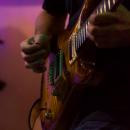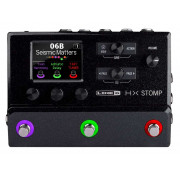Aquí tenéis todas las novedades:
https://line6.com/support/page/kb/effects-controllers/helix/helix-30-release-notes-r934/
Lo acabo de instalar aunque hasta el finde o la semana que viene no podré probarlo,pero vamos,con los 8 bloques,los diezel,simulador de acústica, algunos efectos nuevos muy guapos(ojo los poly detune) o el horizon drive,a priori,me han hecho feliz jeje.
Os dejo algunas cosas
New Amps
US Princess, based on* the Fender® Princeton Reverb
Das Benzin Mega, based on* the Mega channel of the Diezel VH4
Das Benzin Lead, based on* the Lead channel of the Diezel VH4
New Cabs
1x10 US Princess, based on* the Fender® Princeton Reverb cab
1x12 US Princess, based on* the Fender® Princeton Reverb with a 12" Alnico Blue driver
New Effects
Distortion > Horizon Drive (Mono, Stereo), based on* the Horizon Devices Precision Drive. Includes an extra Gate Range parameter that, when set to "Extended," drops the gate's threshold down to -90dB
Distortion > Swedish Chainsaw (Mono, Stereo), based on* the BOSS® HM-2 Heavy Metal Distortion (Made in Japan black label)
Distortion > Pocket Fuzz (Mono, Stereo), inspired by* the Jordan Boss Tone fuzz
Distortion > Bighorn Fuzz (Mono, Stereo), based on* the 1973 Electro-Harmonix® Ram's Head Big Muff Pi
Distortion > Ballistic Fuzz (Mono, Stereo), based on* the Euthymia ICBM fuzz
Dynamics > Horizon Gate (Mono, Stereo), based on* the Horizon Devices Precision Drive's gate circuit. Includes an extra Gate Range parameter that, when set to "Extended," drops the gate's threshold down to -90dB. Works best before an amp
EQ > Acoustic Sim (Mono, Stereo), based on* the BOSS® AC-2 Acoustic Simulator. Includes an extra Shimmer parameter that imparts some motion to the harmonics, reminiscent of how a string's vibration tends to affect the other strings. Can be used alone or in conjunction with an acoustic IR
Modulation > Poly Detune (Mono), Line 6 Original. Great for those who avoid traditional chorus pedals
Delay > Poly Sustain (Mono), Line 6 Original infinite sustain with a modulated poly pitch engine built in
Assign Poly Sustain to a stomp footswitch. By default, Poly Sustain appears bypassed.
First play the note or chord you wish to sustain, and then press the footswitch (on) to sustain it indefinitely. Keep playing while the note or chord loops. TIP: Some players may find it easier to change the footswitch mode to Momentary; that way, the note or chord sustains only while you hold the switch on, much like the sustain pedal on a piano.
Press the switch again (off), and the sustained note or chord fades out.
Interval—Sets the pitch of the sustained note or chord. TIP: This parameter is especially cool for creating massive drones to play over
Attack—Sets the speed at which the sustained note or chord fades in
Decay—Sets the speed at which the sustained note or chord fades out after bypassing the effect
Mod Freq—Sets the speed of the built-in modulation
Mod Depth—Sets the depth of the built-in modulation
FX Level—Sets the level of the sustained signal
RandDpth—Higher values increase the randomization of the section of audio being sustained, resulting in a more natural, but less predictable drone
RandSpeed—Controls how fast the randomization wanders
Level—Controls the overall output level of the block
Delay > Glitch Delay (Mono, Stereo), Line 6 Original performance delay that lets you freely manipulate the repeats' behavior in real-time
Time—Sets the delay time; press the knob to toggle between ms/sec and note values
Delay Div—Divides the delay time into smaller increments
Mix—Controls the wet/dry mix of the delay. When set to 0%, no delay is heard; when set to 100%, no dry signal is heard
Feedback—Controls the overall number of repeats heard for the entire sequence
SliceFdbk—Controls the number of repeats heard for individual slices. At higher values, you could call this "Super Chaotic Feedback"
Shuffle—Determines the likelihood of repeats shuffling/reordering
Octaves—Determines the likelihood of repeats playing back an octave higher or lower
Reverse—Determines the likelihood of repeats playing backward
Seq Drift—Determines the likelihood of the entire sequence changing every time it loops around. When set to 0%, the same sequence loops forever. TIP: Assign this parameter to a footswitch set to toggle between a higher number and 0%. If you hear a random sequence you want to maintain, press the switch to set Seq Drift to 0%, and it'll repeat that way indefinitely
Smoothing—Higher values apply smoothing between slices and can give a synth-pad type quality, lower values maintain transients. Or set it just high enough to avoid pops and clicks
Trails—When on, delay repeats continue to ring out after the block is bypassed
Pitch/Synth > Poly Pitch (Mono), Line 6 Original
NOTE: Polyphonic pitch engines are designed for shifting complex chords with minimal artifacts at the expense of latency (and our algorithms have lower latency than leading standalone poly pitch pedals). If you're looking to pitch individual notes (such as in a solo), monophonic pitch-shifting is often preferred. See the Tracking parameter below for more information
IMPORTANT! 3.0's new poly models are extremely DSP-intensive. Some effects can eat up roughly a quarter of all available DSP on a Helix Floor, Rack, or LT or half (!!!) of all available DSP on HX Stomp or HX Effects. You also can't run more than one on the same path/DSP (unless you're running Helix Native with Hardware Compatibility Mode turned off). Don't say we didn't warn you...
Interval—Sets the pitch of the effect in semitones
Cents—Sets the pitch of the effect in cents
ShiftTime—Determines how long it takes for the signal to ramp up or down to the set pitch when the block is enabled. Press the knob to toggle between ms/Sec and note/beat values. TIP: Want to hit the switch and have Poly Pitch dive bomb and land exactly one bar later? Press the knob to select note values and set ShiftTime to "1/1"
ShiftCurve—Determines the trajectory curve of the pitch shift over time. StartSlow values are concave (slower changes to start, speeding up toward the end); StartFast values are convex (the opposite). At the knob's extremes (Start Slow 5 and Start Fast 5), the pitch will actually overshoot a little before settling on the target pitch. The default is "Linear"
ReturnTime—Determines how long it takes for the signal to return to normal pitch when the block is bypassed. Press the knob to toggle between ms/Sec and note/beat values
ReturnCurv—Determines the trajectory curve when returning to the original pitch. StartSlow values are concave (slower changes to start, speeding up toward the end); StartFast values are convex (the opposite). At the knob's extremes (Start Slow 5 and Start Fast 5), the pitch will actually overshoot a little before settling on the original pitch. The default is "Linear"
Tracking—Determines how the poly pitch engine reacts to your playing. Leave this set to "X Stable" (the default, with the fewest artifacts when pitch shifting complex chords) and only select a different setting if you experience too much latency when playing fast lead lines
Auto EQ—Determines how much compensation EQ is applied to the shifted signal. If the effected signal sounds too harsh when pitched up (or dull when pitched down), adjust this setting to taste. The higher the value, the more EQ is applied at the shift end points; when set to 0.0, no compensation EQ is applied
Mix—Controls the wet/dry mix of the pitch-shift
Level—Controls the overall output level of the block
Pitch/Synth > Poly Wham (Mono), Line 6 Original. Automatically assigned to EXP 1 and the toe switch toggles it on and off. See Poly Pitch notes above for additional information
Pitch/Synth > Poly Capo (Mono), Line 6 Original. A Simpler version of Poly Pitch when you just want to transpose your playing. See Poly Pitch notes above for additional information
Pitch/Synth > 12 String (Mono), Line 6 Original 12-string guitar emulation
Volume/Pan > Stereo Imager (Stereo), Line 6 Original. Used to increase the apparent stereo width of your signal when connecting Helix to two amps or a stereo playback system; just make sure there aren't any mono blocks after it!
Looper > Shuffling Looper (Mono, Stereo), Line 6 Original. Part looper, part sampler, part inspiration generator, part performance instrument, the Shuffling Looper intelligently chops up your playing and gives you real-time control over reordering, octave shifting, reversing, and repeating. It's all immense fun (even on vocals, drums, and percussion), but you'll want to familiarize yourself with its controls. IMPORTANT: The Shuffling Looper does not currently respond to Command Center > HX Commands or per-function MIDI commands
Add the Shuffling Looper to a preset and assign it to a footswitch.
Turn Knob 1 (Slices) to set the number of slices your loop will be chopped into. 8 slices is the default.
Press the switch to begin recording. The LED lights red, indicating the loop is recording.
At the end of your loop, press the switch. The LED lights green, and the sliced loop sequence immediately plays.
During playback, adjust the following knobs (or assign them to controllers, like expression pedals or snapshots):
Slices—Changes the number of slices your loop will be chopped into
SeqLength—Determines the number of slices in the sequence. This can be changed even after recording a loop
Shuffle—Determines the likelihood of slices shuffling/reordering. At 0%, the slices never shuffle; at 100%, they're constantly reshuffling
Octave—Determines the likelihood of slices playing back an octave higher or lower
Reverse—Determines the likelihood of slices playing backward
Repeat—Determines the likelihood of slices repeating
Smoothing—Higher values apply smoothing between slices and can give a synth-pad type quality, lower values maintain transients. Or set it just high enough to avoid pops and clicks
Seq Drift—Determines the likelihood of the entire slice sequence changing every time it loops around. When set to 0.0, the same sequence repeats forever; when set to 10.0, the sequence changes completely every time it loops TIP: Assign this parameter to a footswitch set to toggle between a higher number and 0%. If you hear a random sequence you want to maintain, press the switch to set Seq Drift to 0%, and it'll repeat that way indefinitely
Playback—Sets the looper's playback level
Low Cut—Applies a low cut (or high pass) filter to the loop, letting you remove the looper signal below a certain frequency
High Cut—Applies a high cut (or low pass) filter to the loop, letting you remove the looper signal above a certain frequency
Want to change it up? While the loop is playing, press the switch to randomize its slice sequence.
Quickly double-press the switch. Playback/recording stops, and the LED lights white, indicating a loop is in memory. Press again to restart.
While the loop is playing or stopped, press and hold the switch. The recording is deleted, and the LED lights dim white.
*NOTE: All product names used in this document are trademarks of their respective owners and neither Yamaha Guitar Group nor Line 6 are associated or affiliated with them. These trademarks appear solely to identify products whose tones and sounds were studied by Line 6 during sound model development.
Un saludo















